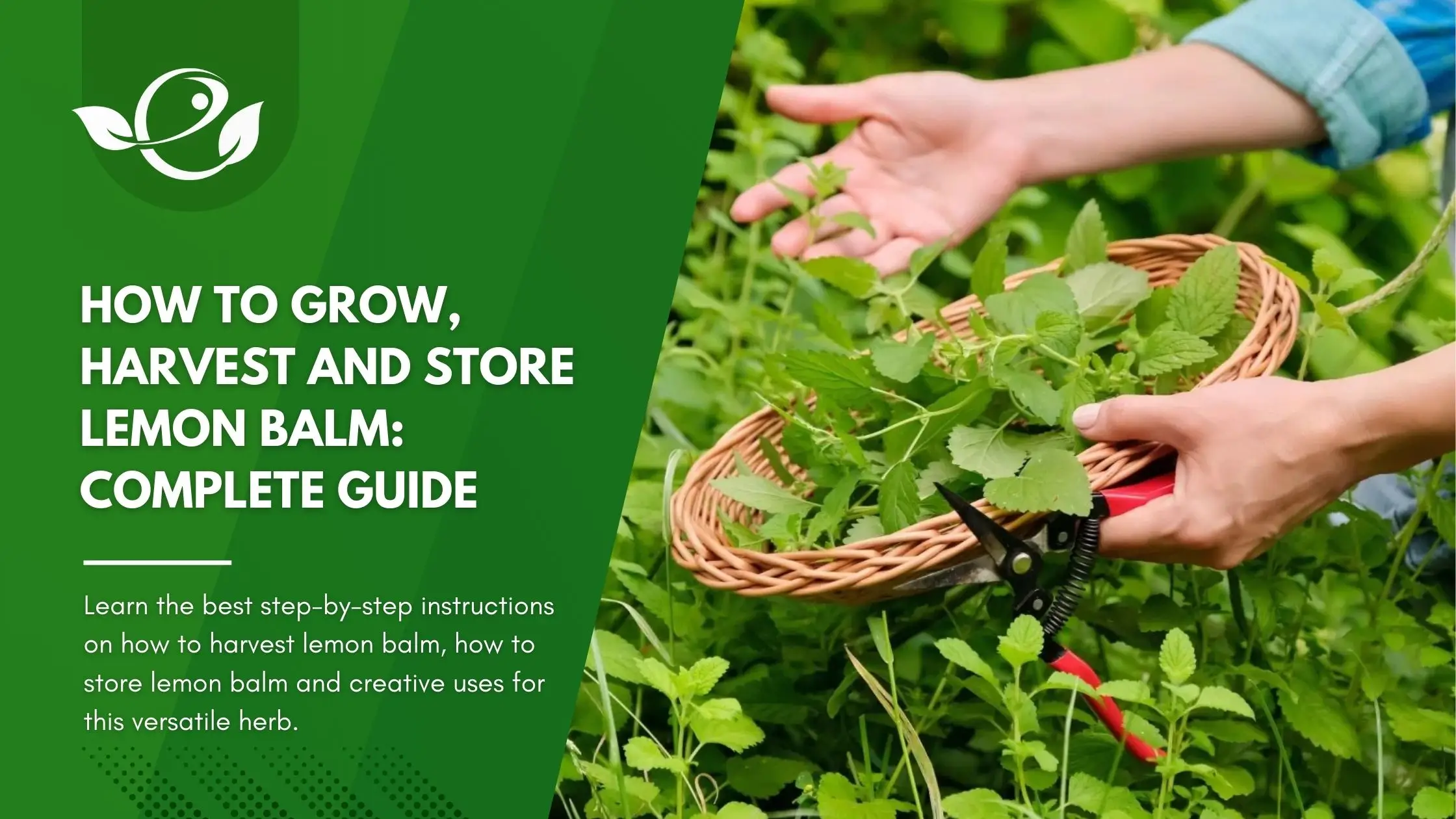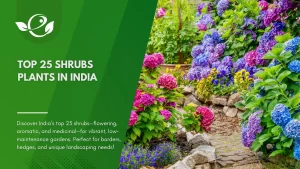Table of Contents
Lemon balm is a versatile herb prized for its culinary, medicinal, and aromatic qualities. Whether you’re a seasoned gardener or just starting out, this comprehensive guide will walk you through every aspect of cultivating lemon balm—from planting and caring for your herb to learning how to harvest lemon balm effectively and store it for long-lasting freshness. Drawing insights from expert sources such as EcoFarming Daily, MasterClass, WikiHow, Hobby Farms, and HGTV, this article provides practical tips and proven strategies to help you maximize the potential of your lemon balm.
Understanding Lemon Balm
A. What Is Lemon Balm?
Lemon balm (Melissa officinalis) is a perennial herb belonging to the mint family. Known for its gentle lemon aroma and calming properties, lemon balm has been used for centuries in herbal medicine, teas, and culinary dishes. Its leaves and flowers offer a mild, refreshing flavor that enhances salads, sauces, and even desserts.
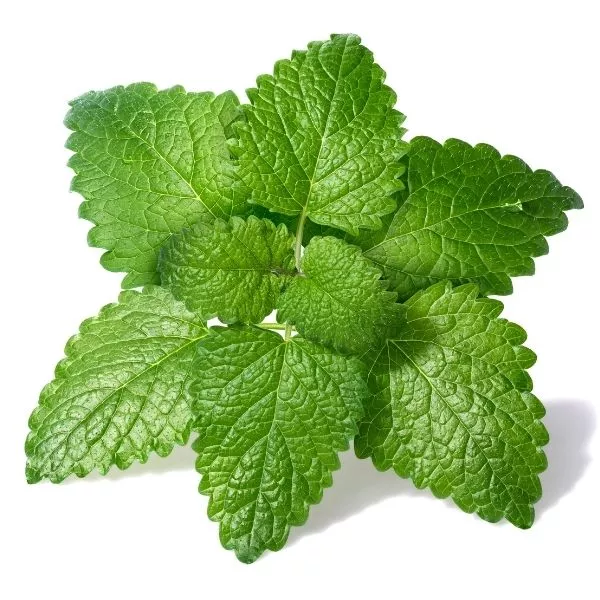
B. Benefits of Growing Lemon Balm
- Culinary Uses: Adds a fresh, citrusy note to teas, salads, marinades, and sauces.
- Medicinal Properties: Traditionally used to reduce stress, aid digestion, and promote sleep.
- Garden Benefits: Serves as a natural pest repellent and companion plant by attracting beneficial insects and deterring harmful ones.
- Ecological Considerations: While lemon balm can be invasive if left unchecked, proper management techniques ensure it enhances rather than dominates your garden.
How to Grow Lemon Balm Successfully
Lemon balm (Melissa officinalis) is an easy-to-grow herb that thrives in various conditions, making it ideal for beginners and experienced gardeners alike. Proper planting and care ensure that your lemon balm remains healthy, flavorful, and productive throughout the growing season. Below, we’ll cover everything you need to know—from choosing the right location to essential maintenance practices that keep your plants thriving.
A. Choosing the Right Location and Soil
Selecting the right site is crucial for optimal growth. Lemon balm adapts to different environments, but specific conditions can enhance its vitality and yield.
1. Sunlight Requirements
- Lemon balm prefers full sun (at least 6–8 hours of direct sunlight per day) but tolerates partial shade.
- In hotter climates, providing afternoon shade can help prevent leaf scorch and excessive moisture loss.
- If growing indoors, place it near a south-facing window or use grow lights to ensure sufficient exposure.
2. Soil Preferences
- Well-draining, loamy soil rich in organic matter provides the best growing conditions.
- The ideal pH range is 6.0–7.5, but it can tolerate slightly acidic to neutral soils.
- If your soil is heavy clay, amend it with compost, sand, or perlite to improve drainage.
- Avoid waterlogged conditions, as excess moisture can lead to root rot and fungal issues.
3. Companion Planting Benefits
- Lemon balm serves as a natural pest deterrent, making it an excellent companion for vegetables such as tomatoes, peppers, and squash.
- Its fragrant foliage attracts pollinators like bees and butterflies, enhancing overall garden productivity.
- Avoid planting near aggressive spreaders like mint, as both belong to the same family and can quickly take over garden spaces.
B. Planting Lemon Balm
Lemon balm can be grown from seeds, cuttings, or transplants. Each method has its advantages, and the choice depends on your gardening goals and timeline.
1. Starting from Seeds
Growing lemon balm from seed requires patience, as germination can take 10–14 days. Here’s how to start:
- Indoor Sowing: Start seeds indoors 6–8 weeks before the last frost to get a head start on the growing season. Use a light seed-starting mix and keep soil temperatures around 65–70°F (18–21°C) for optimal germination.
- Direct Sowing: If planting directly in the garden, wait until soil temperatures reach at least 50°F (10°C) in spring. Scatter seeds lightly, covering them with a thin layer of soil (about 1/8 inch deep).
- Moisture Management: Keep the soil consistently moist but not soggy until seedlings emerge.
2. Growing from Cuttings
Propagating lemon balm from cuttings is an efficient way to clone a strong parent plant and get quicker results:
- Cut a 4–6 inch stem from a mature, healthy plant just below a leaf node.
- Remove the lower leaves and place the cutting in a glass of water or directly into moist potting soil.
- If using water, roots should appear within 7–10 days; transplant once they reach about 1 inch long.
- If planting in soil, keep it moist but not waterlogged, and position the plant in indirect light until roots are established.
3. Transplanting Established Plants
If you purchase a young plant from a nursery or grow seedlings indoors, transplanting ensures a smooth transition to garden beds or containers:
- Timing: Transplant when outdoor temperatures remain above 50°F (10°C) at night.
- Spacing: Place plants 12–18 inches apart, as lemon balm can spread quickly.
- Depth: Keep the root ball level with the soil surface to prevent stem rot.
- Mulching: Add a 2-inch layer of mulch (such as straw or wood chips) to retain moisture and suppress weeds.
C. Caring for Your Lemon Balm
Once established, lemon balm is low-maintenance but benefits from regular care to encourage vigorous growth and prevent potential problems.
1. Watering Guidelines
- Consistent Moisture: Water deeply but infrequently—about once or twice per week, depending on rainfall and soil drainage.
- Drought Tolerance: Lemon balm is moderately drought-tolerant once established but prefers evenly moist soil for the best flavor and growth.
- Overwatering Risks: Avoid excessive watering, as standing water can cause root rot and fungal diseases.
2. Fertilization for Healthy Growth
- Moderate Feeding: Lemon balm doesn’t require heavy fertilization, but occasional feeding enhances foliage production.
- Organic Options: Apply a balanced organic fertilizer (e.g., compost tea or fish emulsion) every 4–6 weeks during the growing season.
- Avoid Overfertilization: Excess nitrogen encourages lush, leggy growth at the expense of flavor and essential oil concentration.
3. Pruning and Controlling Spread
- Regular Pruning: Trim back about 1/3 of the plant every few weeks to encourage bushy growth and prevent legginess.
- Preventing Flowering: Once lemon balm flowers, leaf flavor diminishes. To extend the harvest period, remove flower buds as they appear.
- Managing Invasiveness: Lemon balm can spread aggressively through underground rhizomes and self-seeding. To contain it:
- Grow it in containers if space is limited.
- Install a root barrier if planting directly in garden beds.
- Cut back aggressively in fall to prevent excessive self-seeding.
4. Pest and Disease Prevention
Lemon balm is relatively resistant to pests and diseases, but occasional issues may arise:
- Common Pests:
- Aphids: These small insects suck sap from the leaves. Use a strong spray of water or neem oil to manage them.
- Spider Mites: Typically occur in dry conditions. Increase humidity and use insecticidal soap if needed.
- Fungal Diseases:
- Powdery Mildew: A common issue in humid environments. Improve airflow by spacing plants adequately and pruning regularly.
- Root Rot: Caused by overwatering. Ensure proper soil drainage and avoid excessive irrigation.
D. Seasonal Care and Overwintering
Lemon balm is a perennial in USDA zones 4–9, meaning it can survive winter and return each year with proper care.
1. Fall and Winter Preparations
- In colder climates (zones 3–5), apply a layer of mulch around the base of the plant before winter to protect the roots.
- Trim back the plant to about 2 inches above the soil line after the first frost.
- Container-grown plants should be moved to a sheltered area or indoors if temperatures drop below 20°F (-6°C).
2. Spring Revival
- As temperatures warm, remove excess mulch to allow new growth to emerge.
- Apply compost or a mild organic fertilizer to boost spring growth.
Lemon balm is an excellent herb for any garden, offering aromatic foliage, medicinal benefits, and culinary versatility. By providing the right soil conditions, proper watering, and occasional pruning, you can maintain a healthy, thriving lemon balm plant year after year. With these expert growing tips, you’ll soon have a lush supply of fresh leaves to harvest, whether for tea, cooking, or home remedies.
How to Harvest Lemon Balm Effectively
Harvesting lemon balm (Melissa officinalis) at the right time and using proper techniques ensures maximum flavor, potency, and plant health. Whether you are growing lemon balm for culinary use, herbal teas, or medicinal remedies, knowing when and how to harvest can significantly enhance its aroma, essential oil content, and longevity.
This section provides expert insights on optimal harvesting times, best cutting techniques, seasonal harvesting strategies, and post-harvest handling to help you make the most of your lemon balm plants.
A. When to Harvest Lemon Balm for Maximum Potency
Lemon balm can be harvested throughout the growing season, but the timing plays a crucial role in the plant’s flavor and medicinal properties.
1. Best Time of Day for Harvesting
- Morning (after the dew dries but before midday heat): Essential oil concentrations are at their peak, making this the best time for harvesting.
- Avoid harvesting during hot afternoons, as heat causes rapid oil evaporation, reducing flavor and fragrance.
- If harvesting after rain or watering, allow leaves to dry slightly to prevent mold during storage.
2. Growth Stage Considerations
- Early Harvesting (Before Flowering, Spring to Early Summer):
- Best for culinary and medicinal use, as the leaves contain the highest concentration of essential oils.
- Leaves are more tender and flavorful, making them ideal for fresh tea, cooking, and extracts.
- Mid-Season Harvesting (During Flower Bud Formation, Summer):
- If flowering begins, leaves may start losing potency. Harvesting before full bloom helps preserve essential oil content.
- Removing flowers encourages continued vegetative growth.
- Late-Season Harvesting (Fall, Before Frost):
- Useful for large-scale drying and preservation.
- Leaves tend to be slightly less aromatic but are still suitable for teas, tinctures, and herbal remedies.
- In colder climates, harvesting in late fall ensures you collect as much foliage as possible before the plant dies back for winter.
B. How to Harvest Lemon Balm Without Damaging the Plant
Proper harvesting techniques prolong plant life, encourage bushier growth, and prevent stress.
1. Selecting the Right Tools
- Use sharp scissors, pruning shears, or garden snips to make clean cuts without damaging the plant’s stems.
- Avoid tearing or pinching leaves by hand, as this can cause unnecessary stress and increase susceptibility to disease.
2. Best Techniques for Harvesting Leaves and Stems
- For Light, Regular Harvesting:
- Pick individual leaves or small sprigs (2–4 inches long) as needed for fresh use.
- This method is ideal for continuous kitchen use while keeping the plant healthy.
- For a More Substantial Harvest:
- Cut stems 2–3 inches above the soil level, leaving enough lower leaves to encourage regrowth.
- Always leave at least one-third of the plant intact to allow it to recover quickly.
- Make angled cuts to promote new branching and fuller growth.
- For End-of-Season Harvest:
- If cutting the plant back for winter, trim the entire plant down to about 2 inches above the soil.
- This helps prevent legginess in the following growing season.
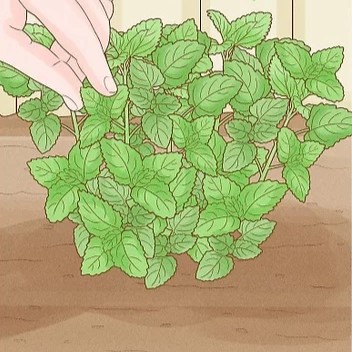
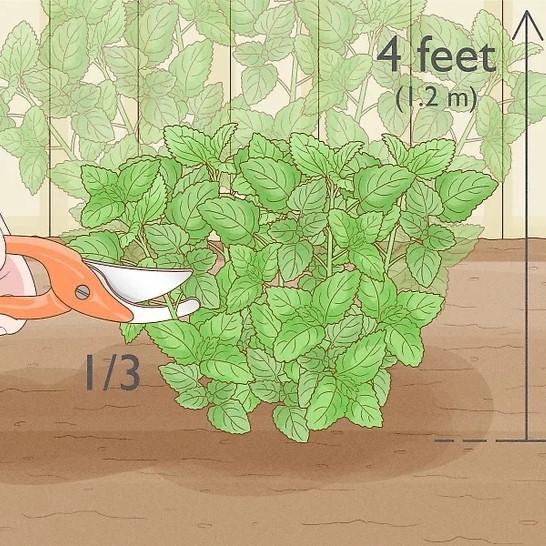
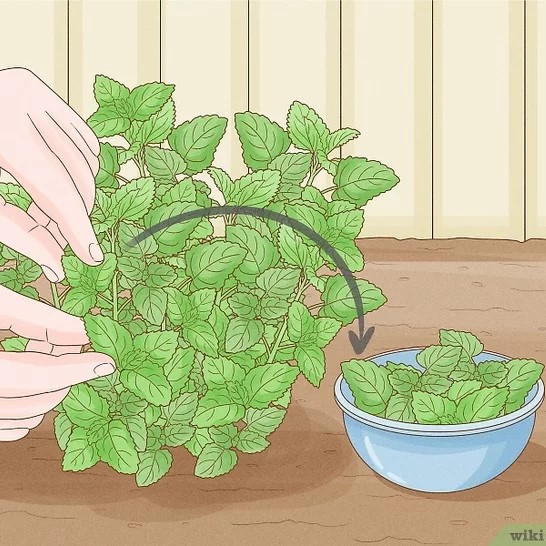
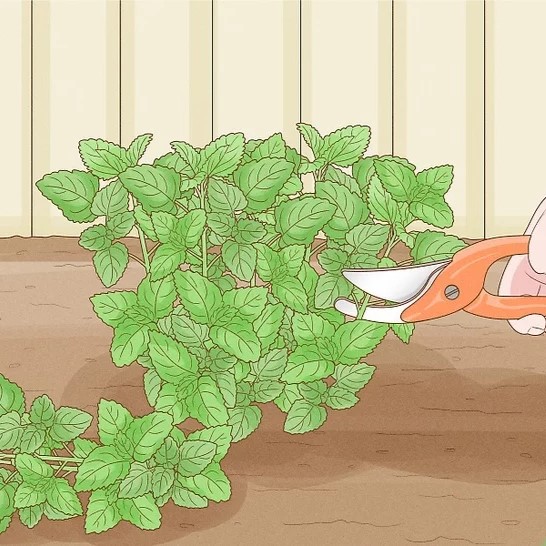
3. Frequency of Harvesting
- Regular Pruning (Every 2–3 Weeks): Encourages new growth and prevents flowering.
- Heavy Harvest (Every 4–6 Weeks): Useful for drying and preserving, but avoid harvesting more than ⅔ of the plant at once.
- Fall Cutback (Final Harvest Before Frost): Ensures maximum use of available foliage before winter dormancy.
C. Seasonal Harvesting Strategies for Maximum Yield
Harvesting lemon balm at different times of the year requires adjustments in technique to maximize yield and ensure the plant remains healthy year-round.
- 1. Spring and Early Summer Harvest
- Prioritize frequent, light harvesting to promote bushy growth and prevent flowering.
- This is the best time for fresh culinary use and herbal infusions.
- Pinch off flower buds early to extend the productive season.
- Mid to Late Summer Harvest
- If harvesting for drying or medicinal use, this is the ideal time to collect large amounts.
- Allow plants to grow slightly larger before cutting back for better regrowth.
- Consider a partial cutback if the plant has started to flower, leaving some sections intact for regrowth.
- Fall Harvest and Winter Preparations
- Conduct a final major harvest before the first frost, especially in colder climates where lemon balm dies back in winter.
- Cut back most of the plant but leave a few inches above ground to allow regrowth in spring.
- Drying and storing at this time ensures you have a winter supply of lemon balm for teas and remedies.
How to Store Lemon Balm for Long-Lasting Freshness
Once you’ve successfully harvested lemon balm, proper storage is essential to preserve its aroma, flavor, and medicinal properties. Whether you want to keep it fresh for a few days or store it for long-term use, choosing the right method will ensure you get the most out of your harvest. Below, we’ll explore the best storage techniques, from short-term refrigeration to long-term drying and freezing methods.
A. Storing Fresh Lemon Balm (Short-Term Storage)
If you plan to use your lemon balm within a few days, keeping it fresh is the best option. Here are two effective methods:
1. Refrigeration Method (Lasts 5–7 Days)
Refrigeration is the easiest way to extend the freshness of lemon balm leaves while maintaining their essential oils. Follow these steps for optimal results:
- Moist Paper Towel Method:
- Rinse the leaves gently under cool water and pat them dry with a clean kitchen towel or paper towel.
- Wrap the leaves in a slightly damp paper towel (not soaking wet, as excess moisture can cause mold).
- Place them in a resealable plastic bag or airtight container.
- Store in the vegetable crisper drawer of your refrigerator at 40°F (4°C).
- Water Jar Method (Best for Whole Stems):
- Trim the ends of the lemon balm stems.
- Place them in a glass or jar filled with about 1–2 inches of water, like a bouquet of flowers.
- Cover the leaves loosely with a plastic bag to retain moisture.
- Keep the jar in the refrigerator and change the water every two days to keep the stems fresh.
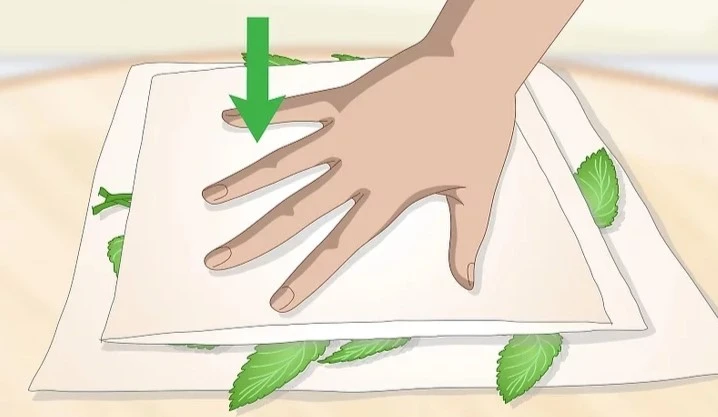

💡 Tip: Avoid storing fresh lemon balm near ethylene-producing fruits (like apples or bananas), as this can cause the leaves to wilt faster.
B. Drying Lemon Balm (Long-Term Storage)
Drying is one of the most effective ways to store lemon balm for months while preserving its flavor and medicinal properties. Proper drying prevents mold growth and ensures the leaves retain their natural essential oils.
1. Air-Drying Method (Traditional and Best for Preserving Flavor)

- Gather small bunches of lemon balm stems and tie them together with twine or a rubber band.
- Hang them upside down in a dry, well-ventilated, and dark space (such as a pantry or closet).
- Ensure good air circulation to prevent mold formation.
- After 7–14 days, check the leaves—when they crumble easily, they are ready for storage.
💡 Best for: Those who prefer a natural, chemical-free method and have the time to wait for a slow drying process.
2. Dehydrator Method (Fastest and Most Efficient)
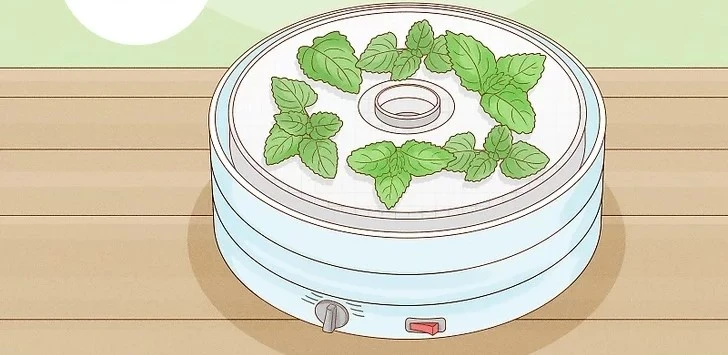
- Spread washed and dried lemon balm leaves in a single layer on dehydrator trays.
- Set the dehydrator to 95–105°F (35–40°C), the ideal temperature for preserving essential oils.
- Check after 2–4 hours—the leaves should be completely dry and brittle to the touch.
💡 Best for: Those who want a quick and controlled drying process with minimal effort.
3. Oven Drying Method (Convenient but Risky for Essential Oils)
- Preheat the oven to the lowest temperature setting (around 120°F or 50°C).
- Arrange the lemon balm leaves in a single layer on a baking sheet lined with parchment paper.
- Leave the oven door slightly open for airflow and dry for 1–2 hours.
- Check frequently to avoid over-drying, as high heat can destroy the delicate flavors.
💡 Best for: Those who don’t have a dehydrator and need a fast method, but it may reduce potency due to heat exposure.
4. Microwave Drying Method (Quickest but Risky for Overheating)
- Place lemon balm leaves between two paper towels on a microwave-safe plate.
- Microwave on low power in 15–20 second intervals, checking in between to prevent burning.
- Continue until the leaves are dry and crisp (usually within 1–2 minutes).
💡 Best for: A quick drying method in small batches, but requires careful monitoring to avoid burning.
C. Freezing Lemon Balm (Retains Freshness for Months)
Freezing is the best method for preserving fresh flavor while keeping lemon balm available for long-term use (up to 6 months). There are several freezing techniques depending on your intended use.
1. Whole Leaf Freezing Method
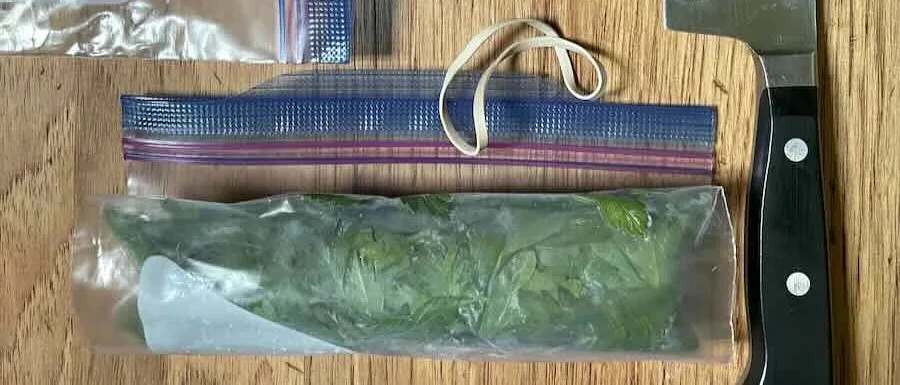
- Rinse and dry lemon balm leaves thoroughly.
- Spread them in a single layer on a baking sheet and place in the freezer for 1–2 hours.
- Transfer the frozen leaves into an airtight freezer bag or container.
- Label with the date and store in the freezer for up to 6 months.
💡 Best for: Quick access to individual leaves for teas and infusions.
2. Ice Cube Method (Best for Cooking & Drinks)
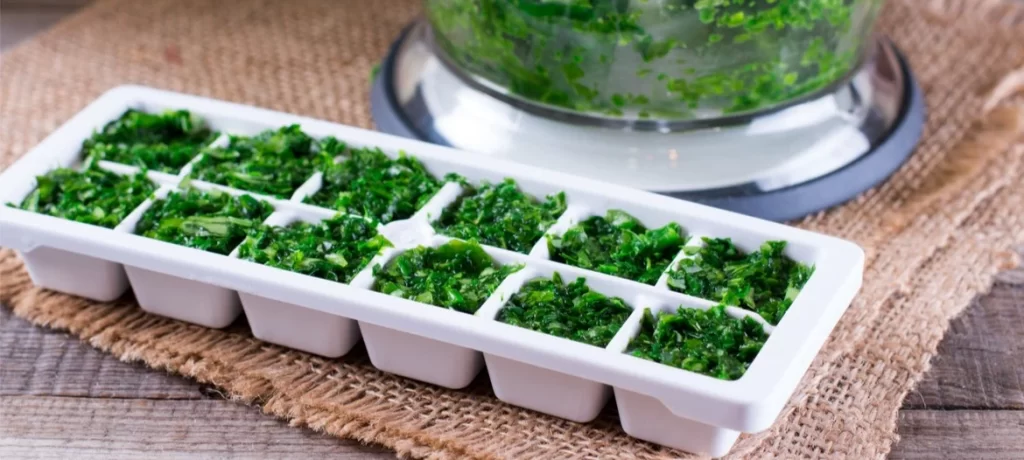
- Chop fresh lemon balm leaves finely.
- Pack them into ice cube trays, filling each section about ¾ full.
- Pour water or olive oil over the leaves to cover them.
- Freeze for 3–4 hours, then transfer the cubes to a resealable freezer bag.
💡 Best for: Easily adding lemon balm flavor to soups, teas, cocktails, or sauces.
3. Lemon Balm Paste Method (Best for Culinary Use)
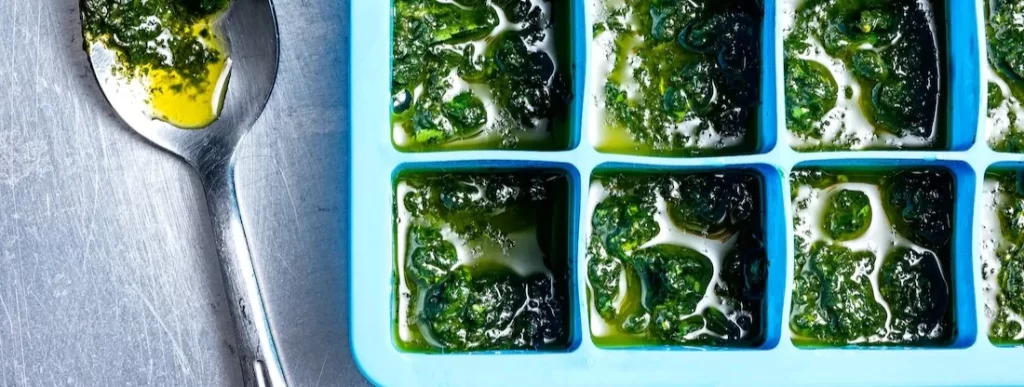
- Blend lemon balm leaves with a small amount of water or oil until a paste forms.
- Transfer the paste into small freezer-safe containers or silicone molds.
- Freeze and store in the freezer for up to 6 months.
💡 Best for: Those who frequently cook with lemon balm in salads, sauces, or dressings.
D. Storing Dried Lemon Balm (Shelf-Stable for Up to 1 Year)
Proper storage of dried lemon balm ensures its potency and freshness for an extended period.
- Choosing the Right Storage Containers
- Store dried leaves in airtight glass jars, vacuum-sealed bags, or dark-colored tins.
- Avoid plastic containers, as they may absorb moisture and degrade the quality.
- Keeping It in an Optimal Location
- Place containers in a cool, dark, and dry place like a pantry or spice cabinet.
- Keep away from direct sunlight, heat sources, and humidity, as these factors can break down the essential oils.
- Shelf Life & How to Check for Freshness
- Properly stored dried lemon balm retains its potency for about 6–12 months.
- To test freshness, crush a few dried leaves—if they release a strong lemony scent, they’re still good.
- If the leaves have lost their aroma or developed a stale/musty smell, it’s time to replace them.
Final Thoughts on Storing Lemon Balm
The best storage method depends on how you plan to use lemon balm:
- Short-term: Refrigeration keeps fresh leaves usable for up to a week.
- Long-term: Drying preserves flavor and medicinal properties for up to a year.
- Freezing: Maintains fresh taste for up to 6 months, making it a great option for teas and cooking.
By following these expert tips, you can enjoy the refreshing lemony scent and flavor of lemon balm all year round! 🌿💚
Creative Uses for Your Harvested Lemon Balm
1. Herbal Tea and Infusions
Lemon balm is widely used to make calming herbal tea that helps reduce stress, improve digestion, and promote restful sleep. To make tea, simply steep fresh or dried leaves in hot water for about 10 minutes. You can enhance its flavor with honey, ginger, or mint. Lemon balm tea is known for its mild citrusy aroma and soothing properties, making it a great choice for winding down after a long day. It also pairs well with other herbs like chamomile and lavender for an even more relaxing blend.
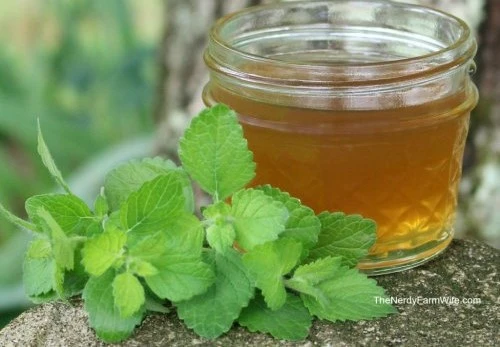
2. Homemade Lemon Balm Syrup
A lemon balm syrup is a versatile addition to your kitchen. You can use it to sweeten tea, drizzle over pancakes, or even mix into cocktails. To make it, simmer lemon balm leaves with sugar and water until it thickens into a syrup. Strain the leaves out and store the syrup in a jar. It provides a refreshing lemony taste that works well in homemade lemonades and desserts like sorbets or fruit salads.
3. Lemon Balm-Infused Honey
Infusing honey with lemon balm not only enhances its flavor but also increases its medicinal value. The antimicrobial and soothing properties of lemon balm make it a great natural remedy for sore throats and coughs. To make this infusion, gently heat honey and add fresh lemon balm leaves, allowing it to steep for a few hours before straining. This infused honey can be used in teas, drizzled over yogurt, or spread on toast for a delightful herbal twist.
4. DIY Herbal Lemon Balm Vinegar
Lemon balm vinegar is an excellent way to add a tangy herbal kick to salads, marinades, and dressings. Simply place fresh lemon balm leaves in a jar and cover them with apple cider vinegar or white wine vinegar. Let it infuse for a couple of weeks before straining. The vinegar takes on the bright citrusy notes of lemon balm and works wonderfully as a light seasoning for vegetables, meats, and even homemade pickles.
5. Natural Skin Care and Beauty Products
Lemon balm is packed with antioxidants and has antibacterial properties, making it a fantastic ingredient for skincare. You can create a soothing facial toner by steeping lemon balm in witch hazel or making a homemade herbal lotion. A lemon balm-infused oil can be used as a base for salves and creams that help soothe irritated skin, minor cuts, and insect bites. Due to its antiviral properties, it is also effective in homemade lip balms for treating cold sores.
6. Lemon Balm Aromatherapy & Stress Relief
The fresh scent of lemon balm is known to have calming and mood-boosting effects. You can make a homemade herbal sachet by drying lemon balm leaves and placing them in small cloth bags to keep in drawers, closets, or under your pillow. Another method is to create a lemon balm essential oil infusion and use it in a diffuser to freshen the air while promoting relaxation and mental clarity.
7. Culinary Uses in Cooking and Baking
Lemon balm can be used in a variety of dishes, both sweet and savory. Chop fresh leaves and add them to salads, fruit bowls, or as a garnish for seafood and poultry dishes. It also works well in baked goods such as muffins, cookies, and scones, imparting a subtle lemony flavor. You can even mix it into homemade butter or cream cheese spreads for a refreshing herbal taste.
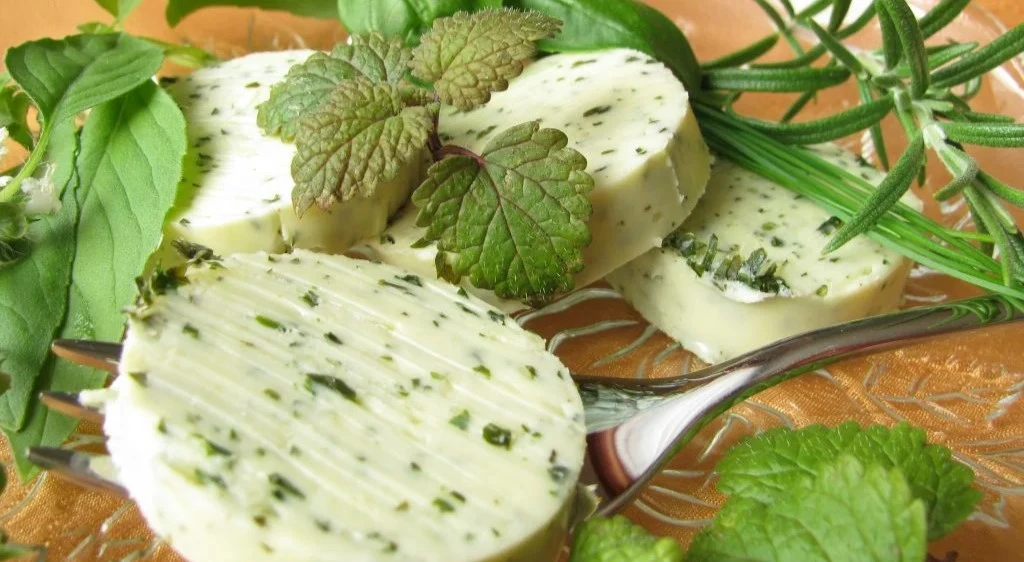
8. Lemon Balm Ice Cubes for Beverages
For a refreshing touch, freeze chopped lemon balm leaves in ice cube trays filled with water or lemon juice. These ice cubes can be added to water, iced tea, or cocktails for a burst of citrusy freshness. They also make a visually appealing addition to summer drinks and infused waters.
9. DIY Herbal Lemon Balm Soap
Homemade soaps infused with lemon balm provide a gentle and natural way to cleanse the skin while enjoying the plant’s antibacterial and aromatic properties. You can add dried lemon balm leaves or a lemon balm oil infusion to a basic soap recipe to create a refreshing herbal bar. It is especially beneficial for soothing irritated skin and reducing acne due to its antimicrobial properties.
10. Natural Pest Repellent
Lemon balm has natural insect-repelling properties, making it a great addition to homemade bug sprays or garden pest control. You can rub fresh leaves directly on your skin to deter mosquitoes or create a simple spray by steeping lemon balm in water with witch hazel. Placing dried lemon balm in sachets around the house can also help keep moths and other pests away.
11. Herbal Lemon Balm Tincture for Wellness
A lemon balm tincture is a concentrated herbal extract that helps with anxiety, digestive issues, and sleep disorders. To make it, soak fresh lemon balm leaves in alcohol (such as vodka) for several weeks, then strain the liquid. Just a few drops of this tincture can be taken daily for its calming and therapeutic benefits. It’s a convenient way to incorporate lemon balm’s healing properties into your routine.
12. Homemade Lemon Balm Candles
Lemon balm can be used to create herbal candles that emit a light citrusy scent when burned. Simply add dried lemon balm leaves or a lemon balm essential oil infusion to melted wax before pouring it into molds. These candles not only make your home smell fresh but also provide calming aromatherapy benefits.
13. Pet Care: Soothing Herb for Animals
Lemon balm is safe for pets and can be used to calm anxious dogs or cats. It can be brewed into a mild tea and added to their water, or a small amount of fresh leaves can be mixed into their food. It is also effective in homemade pet sprays to keep fleas and ticks away naturally.
14. Compost Booster & Garden Uses
If you have an abundance of lemon balm, don’t let it go to waste—add it to your compost pile! Its nutrients will break down and enrich the compost, benefiting your garden. You can also use dried leaves as mulch to deter pests and add nutrients back into the soil.
15. Homemade Lemon Balm Hair Rinse
Lemon balm can be infused into a hair rinse to promote scalp health and add shine to your hair. Simply steep fresh leaves in warm water and use it as a final rinse after shampooing. This herbal rinse can help reduce dandruff and provide a refreshing scent to your hair.
By incorporating lemon balm into your daily routine, you can fully enjoy its benefits in multiple creative ways! Whether for culinary, medicinal, skincare, or household uses, this versatile herb is a valuable addition to your harvest.
Frequently Asked Questions (FAQs)
When is the best time of day to harvest lemon balm?
The optimal time is early morning after the dew has evaporated, ensuring maximum essential oil concentration.
Can I grow lemon balm indoors?
Yes, lemon balm can be grown indoors if provided with adequate sunlight and proper care.
What is the best method to store harvested lemon balm?
For short-term use, refrigerate fresh leaves in a container with a paper towel. For long-term storage, dry the leaves in a well-ventilated area or freeze them.
How can I prevent lemon balm from becoming invasive?
Regular pruning, controlled harvesting, and proper spacing during planting are key strategies to keep lemon balm in check.
What should you not plant next to lemon balm?
You should not plant lemon balm next to mint, basil, or thyme as it can compete aggressively for space and nutrients due to its fast-growing, spreading nature. Additionally, avoid planting it near fennel since fennel can inhibit the growth of nearby plants.
That’s It!
Lemon balm is a dynamic herb that offers a wealth of benefits—culinary, medicinal, and ecological. By following the guidelines provided in this comprehensive guide, you can master the art of growing, harvesting, and storing lemon balm with ease. Remember, knowing how to harvest lemon balm effectively is key to ensuring your plant remains healthy and productive season after season.
We invite you to share your experiences, ask questions, and leave your own tips in the comments below. Happy gardening!
